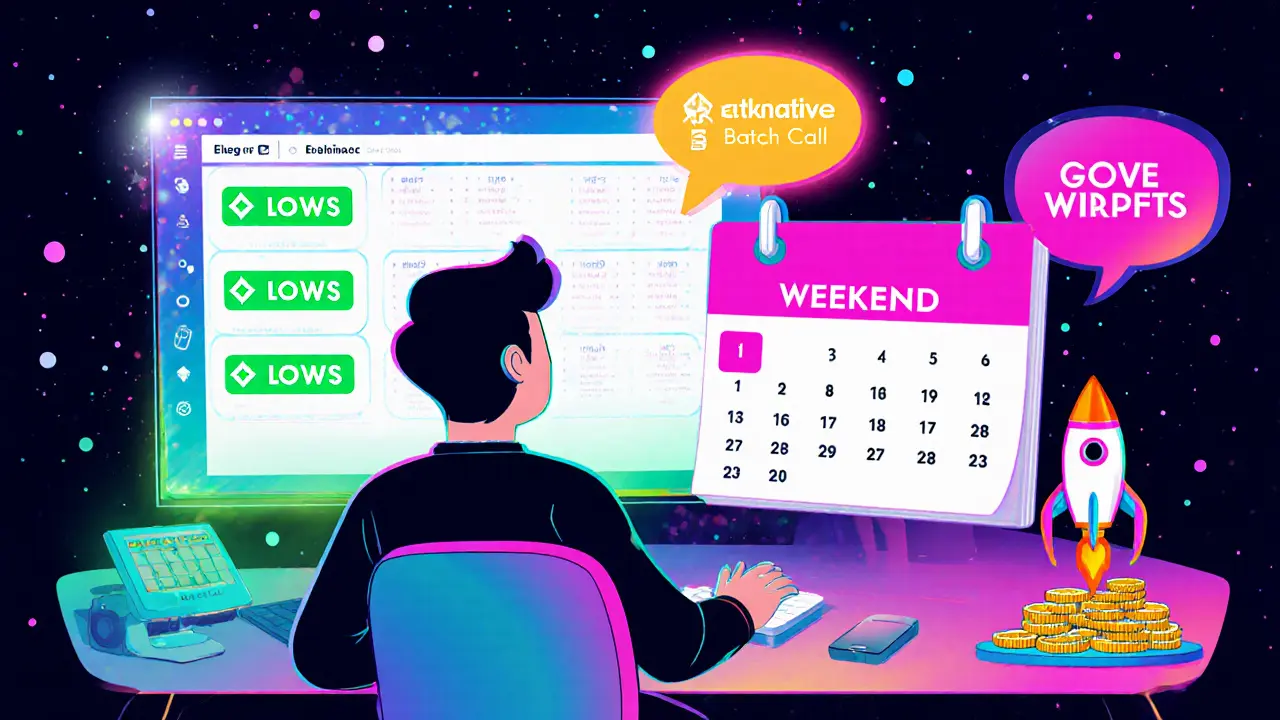Gas Fee Timing Calculator
Optimize Your Gas Fees
Find the cheapest time to execute transactions by selecting your network and fee threshold. This tool shows when gas fees are lowest based on historical patterns.
Key Takeaways
- Gas fees drop 30‑70% during off‑peak UTC windows on Ethereum and Polygon.
- Friday afternoons are typically the most expensive time on Ethereum; Sunday mornings are the cheapest.
- Monitoring tools like Etherscan Gas Tracker or Blocknative can alert you when fees fall below your target.
- Timing works best for non‑urgent, regular transactions; combine it with technical tricks for max savings.
- Upcoming upgrades (EIP‑4844, Gas Hero) will shrink the timing window, so start now.
What are Gas Fees and Why Timing Helps
Gas Fees are the transaction costs paid to validators or miners for processing operations on a blockchain. Every time you send ETH, move an NFT, or interact with a DeFi contract, you pay gas. The amount isn’t fixed - it reacts to how busy the network is. When many users compete for space in the next block, the fee skyrockets; when the network is quiet, the fee plummets.
Because the fee market is driven by supply and demand, you can treat it like a utility bill that varies by the hour. Catching the low‑demand windows means paying far less for the exact same transaction.
Daily and Weekly Fee Patterns on the Biggest Chains
Each network has its own rhythm, but a few patterns recur across the board.
Ethereum (Mainnet)
Ethereum processes roughly 1.1 million transactions a day (Etherscan, Q3 2024). Its fee algorithm (EIP‑1559) adjusts the base fee by up to 12.5% each block depending on congestion.
- Peak window: 9 AM‑5 PM UTC (when European and US markets are open). Gas price can be 2‑3× higher.
- Off‑peak window: 2 AM‑6 AM UTC. Fees often drop 40‑60%.
- Weekly trend: Friday afternoons (UTC) are up ~22% versus Sunday mornings, which are the cheapest.
Polygon (Proof‑of‑Stake)
Polygon handles about 3.2 million daily transactions (Q3 2024) and enjoys the most predictable daily dip.
- Off‑peak (2‑6 AM UTC): average fee ≈ 0.0005 MATIC.
- Peak (9 AM‑5 PM UTC): average fee ≈ 0.0025 MATIC, a 5× jump.
- Weekly swing: about 30% cheaper on weekends.
Avalanche C‑Chain
Avalanche runs ~450 k daily tx (Q3 2024) and uses a more stable fee model after the September 2024 Avalanche9000 upgrade.
- Typical range: 0.25‑2.5 AVAX, less volatile than Ethereum.
- Timing still helps, but savings are usually 10‑20% compared with the 30‑70% on Ethereum/Polygon.
BNB Chain
BNB Chain’s fee swings are modest - roughly 40‑50% between peak and off‑peak, making timing less lucrative but still worthwhile for high‑frequency traders.
Tools That Tell You When Fees Are Low
Manual observation works, but a few free tools automate the process.
- Etherscan Gas Tracker gives live gas price, historical charts, and a simple “Low/Medium/High” badge.
- Blocknative’s Gas Platform (free tier) lets you set alerts for a custom gwei threshold.
- GasNow API (free) can be integrated into scripts to auto‑trigger transactions when price < 30 gwei.
- For Polygon, the official Polygon Gas Station displays real‑time MATIC fee data.
Set your alert around the sweet spot: below 20 gwei on Ethereum, below 30 gwei on Polygon, and below 0.001 AVAX on Avalanche.

Practical Timing Strategies You Can Start Today
- Off‑peak UTC window: Aim for 2‑6 AM UTC for Ethereum and Polygon. That window aligns with low activity in Europe and the US.
- Weekend advantage: Fees dip 30‑40% on Saturdays and Sundays. If your transaction isn’t time‑sensitive, schedule it then.
- Avoid known spikes: Major NFT drops, token launches, or protocol upgrades cause sudden surges. Keep an eye on community calendars.
- Batch when possible: If you need to move multiple tokens, bundle them in a single transaction during a low‑fee window. Saves both gas and time.
- Use gas tokens: Mint a gas token (e.g., CHI or GST2) when fees < 20 gwei, then redeem it when fees spike. This can shave 30‑50% off a costly transaction.
These steps are simple enough for a regular DeFi user and can cut your average spend by roughly a third.
Risks and Limitations of Pure Timing
- Front‑running: Publishing a transaction plan ahead of time can let bots jump in front of you, especially when you wait for a low‑fee window.
- Urgency vs. savings: If you need a trade to execute now (e.g., arbitrage), waiting for a cheaper slot may cost you more than the saved gas.
- Unpredictable events: Sudden market moves, cross‑chain congestion (like the May 2024 Bitcoin halving), or surprise airdrops can invalidate typical patterns.
- Network upgrades: Upcoming changes such as Ethereum’s Prague upgrade (EIP‑4844) will lower base fees, shrinking the timing gap.
Bottom line: timing works best when your transaction is flexible and you can tolerate a few hours of delay.
Combining Timing with Technical Optimizations
Timing alone nets 20‑30% of the total possible savings. Pair it with code‑level tricks for the rest.
- EIP‑1559 awareness: Set a max‑fee slightly above the current base fee; the network will automatically adjust upward if congestion spikes.
- Layer‑2 bridges: Move heavy activity to Optimism, Arbitrum, or Polygon PoS, where fees are already lower.
- Batch calls: Use multicall contracts to combine several actions into one transaction.
- Gas‑hero features: Polygon’s upcoming “Gas Hero” (expected Dec 2024) will auto‑execute during predicted low‑fee windows, essentially automating timing.
- Future upgrades: Ethereum’s EIP‑4844 (proto‑Danksharding) aims to cut base fees by 10‑15% (Ethereum Foundation, Aug 2024). Plan for these changes to reduce reliance on timing.
When you blend the two approaches, you can consistently save 50‑70% of what you’d otherwise pay.
Comparison of Timing Savings Across Networks
| Network | Off‑peak window | Average fee (off‑peak) | Average fee (peak) | Potential savings |
|---|---|---|---|---|
| Ethereum | 02:00‑06:00 UTC | ≈ 15 gwei | ≈ 45 gwei | ~65% |
| Polygon | 02:00‑06:00 UTC | 0.0005 MATIC | 0.0025 MATIC | ~80% |
| Avalanche | Any time (stable) | 0.30 AVAX | 0.50 AVAX | ~40% |
| BNB Chain | Weekend nights | 0.001 BNB | 0.002 BNB | ~50% |
The table shows why Ethereum and Polygon are the top targets for timing; Avalanche’s newer fee model already flattens the curve.
Next Steps for a Personal Timing Plan
- Identify the network you use most often.
- Choose a preferred fee threshold (e.g., lower gas fees under 20 gwei for Ethereum).
- Set up alerts on Etherscan or Blocknative.
- Schedule non‑urgent transactions during the off‑peak window for two weeks and track your savings.
- After the trial, layer in a technical tweak: batch calls or add a gas token.
If the savings aren’t worth the hassle, consider switching to a layer‑2 or a network with intrinsically low fees like Polygon.
Frequently Asked Questions
When is the cheapest time to send an Ethereum transaction?
Generally between 02:00 UTC and 06:00 UTC, especially on weekends. Fees can be 60‑70% lower than during US‑Europe business hours.
Do I need a special wallet to use gas‑token tricks?
No, any wallet that lets you set a custom gas limit (MetaMask, Trust Wallet, hardware wallets) works. You just need to mint the token when fees are low and include it in the transaction later.
Will upcoming upgrades make timing irrelevant?
Upgrades like Ethereum’s EIP‑4844 will shrink the gap, but they won’t eliminate it completely. Timing will still help, just with smaller margins.
Can I automate timing on Polygon?
Yes. Polygon’s upcoming “Gas Hero” feature (Dec 2024) will automatically fire transactions during predicted low‑fee periods. Until then, you can script calls to the Polygon Gas Station API.
What’s the biggest risk of waiting for low fees?
Front‑running and missed opportunities. If the market moves while you wait, you could lose more than the saved gas.

Write a comment